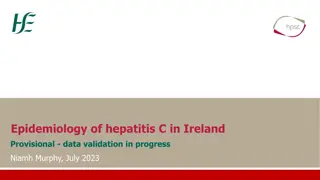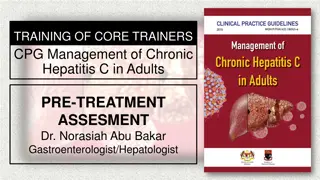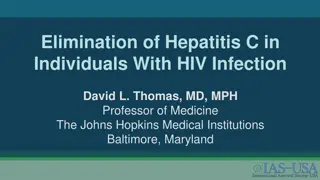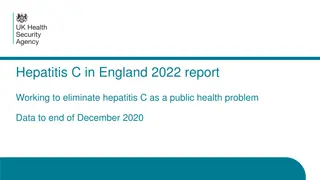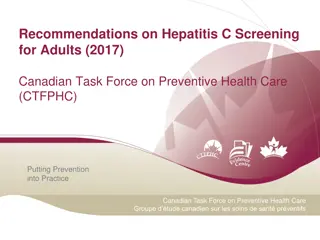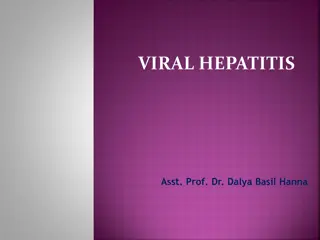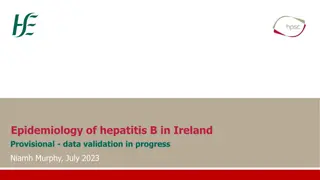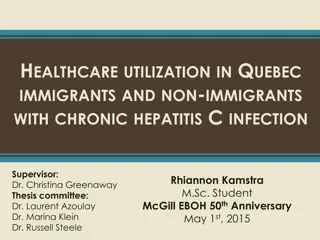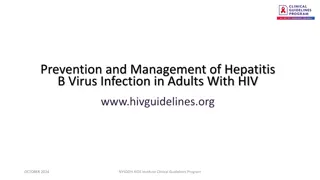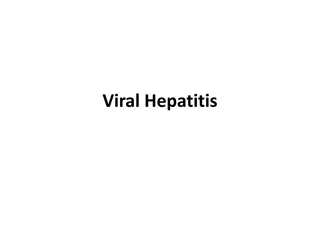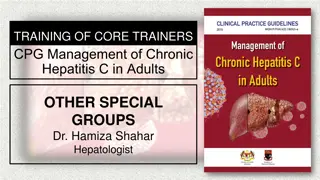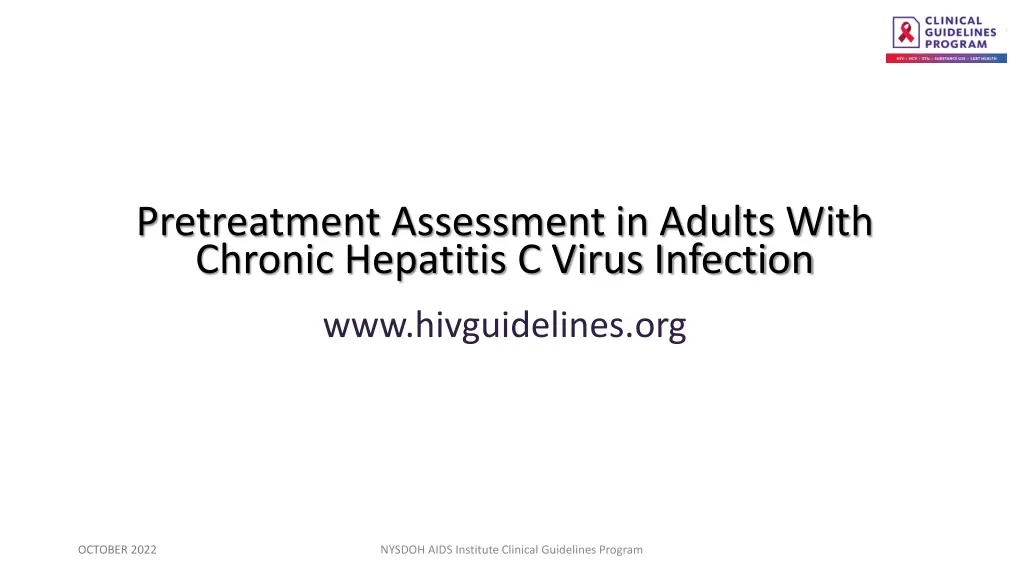
Assessment Guidelines for Chronic Hepatitis C Virus Infection in Adults
These guidelines provide evidence-based recommendations for the pretreatment assessment of adults with chronic Hepatitis C virus infection, aiming to enhance treatment outcomes and support the Hepatitis C Elimination Plan in New York State. Clinicians are advised on key assessment criteria to ensure safe and effective prescription of HCV medications and enhance patient care quality.
Download Presentation

Please find below an Image/Link to download the presentation.
The content on the website is provided AS IS for your information and personal use only. It may not be sold, licensed, or shared on other websites without obtaining consent from the author. If you encounter any issues during the download, it is possible that the publisher has removed the file from their server.
You are allowed to download the files provided on this website for personal or commercial use, subject to the condition that they are used lawfully. All files are the property of their respective owners.
The content on the website is provided AS IS for your information and personal use only. It may not be sold, licensed, or shared on other websites without obtaining consent from the author.
E N D
Presentation Transcript
Pretreatment Assessment in Adults With Chronic Hepatitis C Virus Infection www.hivguidelines.org OCTOBER 2022 NYSDOH AIDS Institute Clinical Guidelines Program
Purpose of This Guideline Purpose of This Guideline Provide evidence-based treatment guidelines to New York State clinicians to increase the number of New York State residents with chronic HCV who are treated and cured. Provide guidance to clinicians on key pretreatment assessment criteria to ensure that HCV medications are prescribed safely and correctly and that all patients receive the highest quality of care. Provide evidence-based clinical recommendations to support the goals of the New York State Hepatitis C Elimination Plan (NY Cures HepC). OCTOBER 2022 NYSDOH AIDS Institute Clinical Guidelines Program www.hivguidelines.org
Recommendations: Recommendations: Medical History and Physical Examination Medical History and Physical Examination Clinicians should assess all patients with a confirmed diagnosis of chronic HCV infection, defined as a positive HCV surface antibody test result and detectable HCV RNA, for treatment. (A1) Clinicians should refer patients with chronic HCV and decompensated liver disease and patients who are pre- or post-liver transplant to a liver disease specialist. (A3) Clinicians new to treating chronic HCV infection should consult with a liver disease specialist when treating chronic HCV in patients with any of the following conditions (A3): Compensated cirrhosis; concurrent hepatobiliary conditions Extrahepatic manifestations of HCV, including renal, dermatologic, and rheumatologic manifestations Significant renal impairment (CrCl <30 mL/min) or who are undergoing hemodialysis Active HBV infection, defined as a positive HBsAg test result and detectable HBV DNA Ongoing HCV infection after failure of treatment with DAAs Treatment after organ transplantation OCTOBER 2022 NYSDOH AIDS Institute Clinical Guidelines Program www.hivguidelines.org
Key Elements of Patient History Key Elements of Patient History Previous treatment for HCV infection: Previous regimen and treatment outcome will guide choice and duration of therapy. History of hepatic decompensation: Warrants referral to a liver disease specialist. History of renal disease: Findings may influence choice of regimen. Medication history and current medications, including over-the-counter and herbal products: Carefully consider potential drug-drug interactions with DAAs. Pregnancy status and plans: HCV treatment may be deferred during pregnancy. Clinician could discuss the possibility of clinical trial participation and refer patient as appropriate. Birth control use is recommended during HCV treatment due to limited data on the safety of treatment during pregnancy. For patients who have been exposed to DAA treatment during pregnancy, contact the Treatment in Pregnancy for Hepatitis C Registry. OCTOBER 2022 NYSDOH AIDS Institute Clinical Guidelines Program www.hivguidelines.org
Key Elements of Patient History, Key Elements of Patient History, continued continued HIV infection: If HIV infection is confirmed, offer the patient ART. If the patient is being treated with antiretroviral medications, assess potential drug-drug interactions. HIV infection may influence fibrosis assessment modality, choice of treatment, treatment duration, and monitoring. History of infection/vaccination status: HAV: Obtain HAV antibody test (IgG or total). HBV: Obtain HBsAg, anti-HBs, and anti-HBc (total). Pneumococcal: Administer pneumococcal polysaccharide vaccine to all patients with cirrhosis, which is associated with increased susceptibility to bacterial infections. Influenza: Administer annual influenza vaccine. OCTOBER 2022 NYSDOH AIDS Institute Clinical Guidelines Program www.hivguidelines.org
Pretreatment Physical Examination Pretreatment Physical Examination Key Element Clinical Details Presence or absence of ankle edema, abdominal veins, jaundice, palmar erythema, gynecomastia, spider telangiectasia, ascites, encephalopathy, and asterixis Presence may suggest cirrhosis or decompensated cirrhosis and may require additional evaluation and management or treatment. Presence or absence of physical signs related to extrahepatic manifestations of HCV, such as porphyria cutanea tarda, vasculitis, or lichen planus Presence may increase urgency of HCV treatment and may require additional evaluation and treatment needs. Liver size by palpation or auscultation for hepatomegaly or splenomegaly, as well as tenderness or hepatic bruits Size and tenderness may suggest the severity of liver disease and may require additional evaluation. OCTOBER 2022 NYSDOH AIDS Institute Clinical Guidelines Program www.hivguidelines.org
Key Points: Key Points: Barriers to Adherence Barriers to Adherence The purpose of the adherence assessment is to optimize support, not to deny access to treatment. Though HCV treatment regimens are relatively short, assessing a patient s readiness for treatment and ability to adhere to a medication regimen and medical care appointments before initiating DAA therapy is essential. After the pretreatment assessment and before treatment initiation, a plan can be developed with the patient to address potential barriers and put support resources in place. OCTOBER 2022 NYSDOH AIDS Institute Clinical Guidelines Program www.hivguidelines.org
Pretreatment Laboratory Testing Pretreatment Laboratory Testing Test Clinical Note Quantitative HCV RNA Confirms active HCV infection and determines HCV viral load. Genotype/subtype Genotype and subtype guide choice of regimen. Low platelet count (<140,000 platelets/ L) suggests cirrhosis and portal hypertension. Anemia may necessitate choice of a regimen that does not contain ribavirin. Marked electrolyte abnormalities may suggest decompensated cirrhosis (e.g., hyponatremia). Renal function will influence choice of regimen. Elevated direct bilirubin suggests decompensated cirrhosis. Markedly elevated transaminases may suggest comorbidities. Complete blood count Serum electrolytes with creatinine Hepatic function panel INR Elevated INR suggests decompensated cirrhosis. Pregnancy test for all individuals of childbearing potential If patient is pregnant, suggest treatment deferral. OCTOBER 2022 NYSDOH AIDS Institute Clinical Guidelines Program www.hivguidelines.org
Pretreatment Laboratory Testing Pretreatment Laboratory Testing Test Clinical Note HAV antibodies Obtain HAV antibody test (IgG or total) and administer the full HAV vaccine series in patients not immune to HAV. Obtain HBsAg, anti-HBs, and anti-HBc (total) and recommend administration of the HBV vaccine series (0, 1, and 6 months) for HBV-susceptible patients (negative for all serologies). In patients with a positive HBsAg test result, perform HBV DNA testing to assess for active HBV infection. If HBV DNA is detectable, care providers new to HCV treatment should consult a liver disease specialist regarding treatment for HBV and HCV. HBV antibodies HIV test if status is unknown If HIV infection is confirmed, offer the patient antiretroviral therapy. Urinalysis Protein may suggest extrahepatic manifestation of HCV. Fibrosis serum markers If not previously evaluated by biopsy or FibroScan. OCTOBER 2022 NYSDOH AIDS Institute Clinical Guidelines Program www.hivguidelines.org
Recommendations: Recommendations: Fibrosis Assessment Fibrosis Assessment Clinicians should assess the degree of fibrosis in patients with chronic HCV infection to aid in determining the need for pretreatment varices and HCC screening, the duration of antiviral treatment, whether the regimen should include RBV, and post-treatment follow-up. (A1) Clinicians should assess patients with chronic HCV for decompensated liver disease (A1) and, if present, refer patients with decompensated cirrhosis to a liver disease specialist. (A3) OCTOBER 2022 NYSDOH AIDS Institute Clinical Guidelines Program www.hivguidelines.org
Methods for Staging Fibrosis Methods for Staging Fibrosis Method Procedure Advantages Noninvasive Inexpensive Disadvantages Indirect serum markers APRI, FIB-4 Limited ability to differentiate intermediate stages of fibrosis Noninvasive Easily accessible Direct markers FibroSure, FibroTest, FibroMeter, FIBROSpect II, and HepaScore Limited ability to differentiate intermediate stages of fibrosis May be difficult to interpret in F2 and F3 liver disease Limited availability Invasive procedure Costly Sampling error Noninvasive Assesses large volume of liver parenchyma VCTE Shear wave velocity Diagnostic standard Diagnoses concurrent liver disease Liver biopsy Pathologic examination OCTOBER 2022 NYSDOH AIDS Institute Clinical Guidelines Program www.hivguidelines.org
Recommendations: Recommendations: Cirrhosis Evaluation Cirrhosis Evaluation Clinicians should determine the severity of cirrhosis (A1) and refer patients with a history of decompensation or decompensated cirrhosis (CTP class B or C) to a liver disease specialist. (A3) Clinicians should refer all patients with HCV-related cirrhosis for an upper endoscopy to screen for the presence of esophageal varices. (A3) Clinicians should screen for HCC with ultrasound, CT, or MRI every 6 months in patients with HCV-related bridging fibrosis or cirrhosis. (A3) OCTOBER 2022 NYSDOH AIDS Institute Clinical Guidelines Program www.hivguidelines.org
Calculating the Child Calculating the Child- -Turcotte for Severity of Cirrhosis for Severity of Cirrhosis Turcotte- -Pugh (CTP) Score Pugh (CTP) Score 1 point 2 points 3 points Encephalopathy None Stage 1 to 2 Stage 3 to 4 (or chronic) (or precipitant-induced) Ascites None Mild/moderate (diuretic-responsive) Severe (diuretic-refractory) Bilirubin (mg/dL) <2.0 2.0 to 3.0 >3.0 Albumin (g/dL) >3.5 2.8 to 3.5 <2.8 Prothrombin time (sec prolonged) or international normalized ratio (INR) <4.0 4.0 to 6.0 >6.0 <1.7 1.7 to 2.3 >2.3 OCTOBER 2022 NYSDOH AIDS Institute Clinical Guidelines Program www.hivguidelines.org
Baseline Evaluation and Follow Baseline Evaluation and Follow- -Up Screening for Patients With Cirrhosis for Patients With Cirrhosis Up Screening Type of Evaluation Rationale Assess for decompensation; refer to a liver disease specialist if history of or current decompensation Decompensation is defined as the presence (or history) of 1 of the following: CTP class B or C MELD score of >15 Ascites Hepatic encephalopathy Portal hypertensive bleeding HCC Intractable pruritus Hepatopulmonary syndrome Portopulmonary hypertension Abdominal ultrasound to screen for HCC Ongoing HCC surveillance should be performed for patients with bridging fibrosis or cirrhosis every 6 to 12 months. Upper endoscopy Refer to a liver disease specialist to screen for varices. OCTOBER 2022 NYSDOH AIDS Institute Clinical Guidelines Program www.hivguidelines.org
Recommendations: Recommendations: Renal Status Renal Status Clinicians should assess CrCl in all patients with HCV. (A1) Clinicians new to HCV treatment should consult a liver disease specialist when treating patients with severe renal impairment (CrCl <30 mL/min). (A3) OCTOBER 2022 NYSDOH AIDS Institute Clinical Guidelines Program www.hivguidelines.org
Recommendations: Recommendations: HAV and HBV Immunity Status HAV and HBV Immunity Status Clinicians should obtain HAV antibody (IgG or total) testing and administer the full HAV vaccine series in patients who are not immune to HAV. (A3) Clinicians should obtain HBsAg, anti-HBs, and anti-HBc test results (total) and should recommend administration of the HBV vaccine series (at 0, 1, and 6 months) for HBV-susceptible patients (negative for all serologies). (A3) In patients with positive HBsAg test results, clinicians should perform HBV DNA testing to assess for active HBV infection. (A1) If HBV DNA is detectable, clinicians new to HCV treatment should consult a clinician experienced in managing both HBV and HCV. (A1) Key Point: For patients with active HBV infection, treatment of both HBV and HCV should be provided in consultation with a clinician experienced in managing both HCV and HBV. OCTOBER 2022 NYSDOH AIDS Institute Clinical Guidelines Program www.hivguidelines.org
Need Help? Need Help? NYSDOH AIDS Institute Clinical Guidelines Program www.hivguidelines.org
Access the Guideline Access the Guideline www.hivguidelines.org > Pretreatment Assessment in Adults With Chronic Hepatitis C Virus Infection Also available: Printable pocket guide and PDF NYSDOH AIDS Institute Clinical Guidelines Program www.hivguidelines.org


